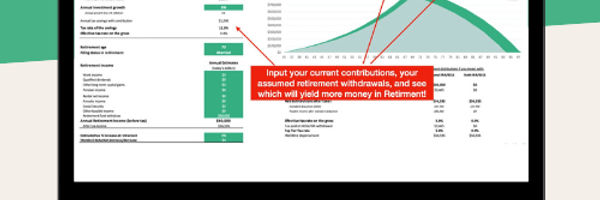Perhaps the single most important retirement account available to employees today is their 401(k) plan. In this article, we're going to discuss the current (2020 and 2021) 401(k) contribution limits, including catch-up limits, pre-tax and total contribution limits, as well as those that apply to highly-compensated employees.

Roth IRA or 401k? This template will answer your questions.
With this template, you will get:
All DFY, simply add your details
Charts for comparison and clear answer
Easily update for any year (2023, 2024, 2025, etc…)

Background of 401(k) Contribution Limits
There is good news for anyone that's been procrastinating, or short-changing their 401(k) plan. Part of the Restoring Earnings to Lift Individuals and Empower Families (RELIEF) Act of 2001, now allows individuals to start building-up that retirement account, and in some cases, catch-up on some lost time.
Additional Resources |
For many years, the 401(k) contribution limits suffered from a lack of attention. Specifically, they were moving up each year at too slow of a pace. Even those participants that contributed faithfully to these accounts, and at the plan limits, were not seeing enough growth to ensure a financially secure retirement. But that's no longer a problem today.
401(k) Contribution Limits
The recent changes in 401(k) contribution limits are good news for investors willing to leverage these plans in their retirement portfolio. Starting back in 2004, the contribution limits increased quickly, and in 2022 will continue to be indexed to inflation.
Pre-Tax 401(k) Contribution Limits
Let's take a quick look at the individual pre-tax contribution limits set by the IRS in the recent past, and over the next few years:
2008 - $15,500
2009 - $16,500
2010 - $16,500
2011 - $16,500
2012 - $17,000
2013 - $17,500
2014 - $17,500
2015 - $18,000
2016 - $18,000
2017 - $18,000
2018 - $18,500
2019 - $19,000
2020 - $19,500
2021 - $19,500
2022 - $19,500 plus an index for inflation ($500 increments)
As the table above demonstrates, the 2022 contribution limits that apply to 401(k) plans will be indexed for inflation; a type of cost-of-living index. These limits can move up in $500 increments in the future. New limits are typically available in mid to late October.
For those individuals that were putting off retirement planning, and have reached age 50 or over, there is an added benefit in the form of a catch-up provision.
Pre-Tax 401(k) Catch Up Limits
A catch up limit is just what it sounds like, the current 401(k) rules allow for plan participants that reach age 50 before the calendar year is over to make additional catch up contributions on a pre-tax basis as shown below:
2008 - $5,000
2009 - $5,500
2010 - $5,500
2011 - $5,500
2012 - $5,500
2013 - $5,500
2014 - $5,500
2015 - $6,000
2016 - $6,000
2017 - $6,000
2018 - $6,000
2019 - $6,000
2020 - $6,500
2021 - $6,500
2022 - $6,500 plus an index for inflation ($500 increments)
As was the case with the "standard" contribution limits, the "catch-up" contributions will continue to be indexed for inflation in 2022, and can increase in $500 increments. In 2021, the catch up remains at $6,500.
Matching Contributions
In addition to the elective deferrals made by employees, an employer may also offer their employees matching 401(k) contributions. Usually an employer's match is limited to a percentage of an employee's pre-tax contribution.
For example, if an employee decides to contribute $10,000 to their 401(k) plan, and the employer matches 50 cents on the dollar, then the total contribution to the plan would be $15,000 in that calendar year.
Highly-Compensated Employees
Individuals that are classified as a "Highly Compensated" employee may be subjected to contribution limits based on their employer's overall 401(k) participation rates. Anyone with a salary above $130,000 in 2020 and 2021 may need to contact their employer to see if any additional limits apply.
For a highly-compensated employee, the total of their elective deferrals and contributions made by their employer under a section 401(k) plan or SARSEP can be no more than 125% of the average deferral percentage (ADP) of all eligible non-highly compensated employees in a calendar year.
If the total contributed to the plan is in excess of the amount allowed under the ADP test, then any excess contributions must be either distributed back to the employee or re-characterized as after-tax employee contributions. For example, the contribution can be distributed to an employee, and then contributed by the employee right back into the plan.
Highly-compensated employees must report these excess 401(k) contributions as taxable income on IRS Form 1040, line 7. An employee should receive a Form 1099-R in any year in which an excess contribution is distributed to them.
After-Tax / Total 401(k) Contributions
In addition to the pre-tax or tax-deferred contributions individuals can make to their 401(k) plan, some plans may also allow employees to make after-tax contributions. When after-tax contributions are added to pre-tax contributions, this becomes an individual's total 401(k) contribution, which also has a limit.
In 2020, the total that can be contributed to a 401(k) plan is $57,000 or 100% of compensation, whichever is less. In 2021, this total 401(k) contribution limit was indexed to inflation, and increases to $58,000.
Access to Contributions
Earnings on all contributions are considered tax-advantaged, and fall under the 401(k) withdrawal guidelines. However, after-tax contributions are considered fully accessible to the employee, since taxes have already been paid on those funds.
The rules for qualified retirement plans are complex. An employee's plan administrator should have documentation outlining the exact rules that apply to the company's plan. That document should explain these limitations, as well as other rules or regulations that might apply.

Roth IRA or 401k? This template will answer your questions.
With this template, you will get:
All DFY, simply add your details
Charts for comparison and clear answer
Easily update for any year (2023, 2024, 2025, etc…)

About the Author - 401(k) Contribution and Catch-up Limits



.jpg)
.jpg)